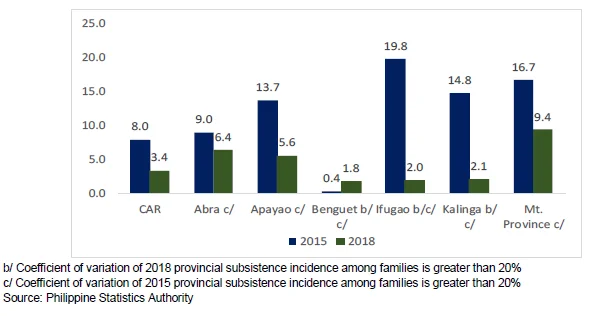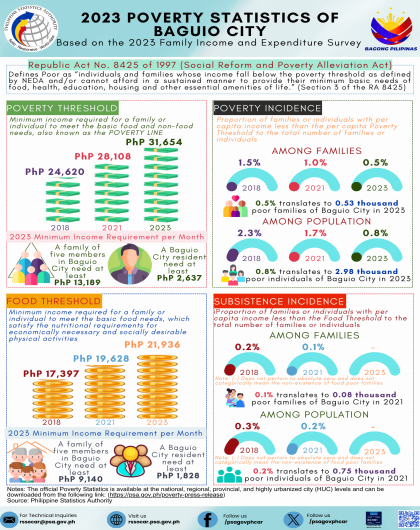Poverty Threshold
- The poverty threshold of the Cordillera Administrative Region (CAR) in 2018 was estimated at PhP 24,874 per capita per annum. This translates to a minimum of PhP 10,364 monthly take home income for a family of five to meet both basic food and non-food needs and be considered not poor in 2018.
Table 1. Annual Per Capita Poverty Threshold by Province,
CAR: 2015 and 2018
- Mountain Province had the highest poverty threshold among the provinces in CAR with PhP 27,726 per capita per annum for 2018 followed by Ifugao with PhP 26,424. These poverty thresholds were above the CAR poverty threshold by 11.5% and 6.2% for Mountain Province and Ifugao, respectively.
-
Kalinga recorded the highest increase in poverty threshold among provinces of CAR with 13.3% increase from PhP 21,348 in 2015 to PhP 24,193 in 2018. On the other hand, Apayao recorded 0.8% reduction in its poverty threshold from PhP 23,310 in 2015 down to PhP 23,135 in 2018.
Food Threshold
- In 2018, the estimated annual per capita food threshold in the Cordillera was PhP 17,380. With this, a family of five needed at least an average monthly income of PhP 7,242 to meet basic food needs. Below this amount, a family was considered subsistence poor or food poor.
Figure 1. Annual Per Capita Food Threshold by Province, CAR: 2018
- Among the provinces of CAR, Mountain Province had the highest food threshold with PhP 19,373 per capita per annum, followed by Ifugao at PhP 18,447. Both provinces had higher food thresholds than the region.
-
Apayao had the lowest food threshold with PhP 16,155 that incurred a negative percent change.
Poverty Incidence Among Population
- Poverty incidence among population in CAR decreased by 10.4 percentage points from 22.6% in 2015 to 12.2% in 2018. This meant a reduction of 24,874 poor persons in 2018 compared to an estimated 22,995 individuals that graduated from being poor in 2015.
Figure 2. Poverty Incidence Among Population by Province,
CAR: 2015 and 2018
Subsistence Incidence Among Population
- The subsistence incidence among population in the region dropped by 4.6 percentage points.
Figure 3. Poverty Incidence Among Population by Province,
CAR: 2015 and 2018

- Generally, there was a decrease in the subsistence incidences of the provinces except Benguet that had an increase in its subsistence incidence by 1.4 percentage points.
Poverty Incidence Among Families
- Poverty incidence among families in CAR decreased by 8.3 percentage points from 17.0 percent in 2015 to 8.7 percent in 2018.
Figure 4. Poverty Incidence Among Families by Province,
CAR: 2018

- Mountain Province had the highest poverty incidence among families in 2018 with 17.2 percent followed by Apayao and Abra with 16.0 percent and 15.0 percent, respectively. Benguet had the lowest poverty incidence although it was only the province that increased in its poverty incidence from the 2015 poverty incidence.
- Only Benguet recorded an increase in its poverty incidence among families but it is still the lowest incidence among the provinces.
- Kalinga incurred the biggest reduction on poverty incidence among families with 25.2 percentage points followed by Ifugao and Apayao with 25.1 and 22.1 percentage points, respectively.
Income Gap, Poverty Gap and Severity of Poverty
- The income gap in CAR was estimated at 21.4% which means that a poor family of five in the region needed an additional monthly income of PhP 2,218 relative to the estimated PhP 10,364 minimum monthly take home income to move out of poverty.
Table 3. Income Gap, Poverty Gap and Severity of Poverty by Province,
CAR: 2015 and 2018



